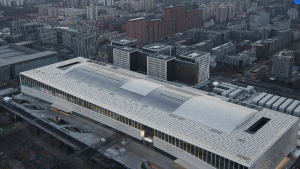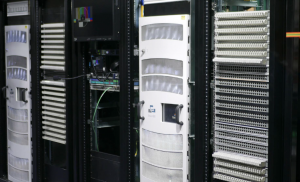IBC facilities in Beijing continue to go greener and become more efficient
The Beijing Games are in their final week, and their conclusion will give all involved plenty of time to reflect on operations since the next Games as the 2024 Paris Summer Olympics are nearly 30 months away.
This has been a unique Olympics for many reasons, not the least of which is that only eight rights holding broadcasters (RHB’s) have a base of operations at the IBC (representing 38 organisations, including sublicensees). In Zhangjiakou, five RHBs representing 16 organisations have facilities at the ZBC. And, at both broadcast centers, Olympic Broadcast Services (OBS) has endeavored to be more sustainable, green, and efficient.

The Beijing Olympics IBC has been reduced to only 30,000 square metres
At the IBC and ZBC, according to Tomoyo Sato, senior manager for broadcaster services at OBS, broadcaster offices range from small units with a few desks and computers to broadcast spaces housing several control rooms, TV studios, editing suites, off-tube commentary booths, news-production areas, and other office rooms,.
OBS technical facilities operate mainly from an area called OBS Tech, located within the IBC, which is made up of the Contribution, Distribution, and Unilateral (CDU) master control room (MCR), the International Transmission MCR, the Commentary Switching Centre (CSC), the Archive Video Logging Area and Mixed Zone Feed Area, and the Broadcast Data Feed (BDF) room.
“Additionally, OBS has also built two TV towers to offer RHBs TV studios and standups for their news reporting,” says Sato. “The Beijing TV tower is located in front of the Bird’s Nest National Stadium and Beijing Medals Plazas. In Zhangjiakou, the TV tower is adjacent to ZBC and facing the National Ski Jumping Centre.”
Eugenia Sofia Fuenmayor, director, construction, OBS, notes that, as part of a long-term commitment to sustainability, OBS has been rethinking the design of the IBC, making optimization of space usage a priority.
For Beijing 2022, OBS has succeeded in reducing the overall net broadcast footprint from 36,000 square metres to 30,000 square meters by facilitating the integration of the IBC and the Main Press Center (MPC) into a single venue, instead of the two initially planned.
Bringing the IBC and the MPC under the same roof allowed a broad range of facilities and services, which otherwise would have had to be duplicated, to be shared by press and broadcasters, reducing costs for the OCOG while optimising Games-time operations.

Locating technical areas centrally in the IBC reduces the energy required in cooling equipment racks
“In order to optimise the broadcast operation and for the first time in an Olympic Winter Games, OBS has designed a series of Centralised Technical Areas (CTAs) strategically placed within the IBC and ZBC,” Fuenmayor explains. “These areas provide ‘data centre’ type of services and infrastructure to both OBS and the RHBs, enabling broadcasters to keep their technical equipment that receives or sends signals from and to OBS, saving energy by reducing the heat, ventilation, and air-conditioning and technical power consumption.”
Fuenmayor adds that the areas are shared by several RHBs, with the more efficient use of space being more cost effective for the broadcasters. “OBS has created a better mix of technical areas and office space to help better balance airflow and reduce the amount of heating and cooling required, thereby lowering power consumption across the facility.”
For Beijing 2022, taking into account RHBs’ space requirements, OBS has built 12 fitted-out compartments, six on each level, at the IBC and an additional 12 distributed on one floor at the ZBC.
“An enhanced modular and prefabricated system helped reduce the fit-out timelines significantly,” says Fuenmayor. “With an innovative, completely clean-and-dry fit-out system, OBS was able to reduce the timeline by a month and half, about 20%. The prefabricated fit-out system, based on steel- sheet panels, will be reused for the next three Games editions, resulting in a significant reduction of construction waste.”
Further gains are likely in Paris in 2024. Looking toward future Games editions, OBS has integrated a series of enhancements to facilitate fit-out construction with little to virtually no impact on preexisting structures and legacy buildings.
